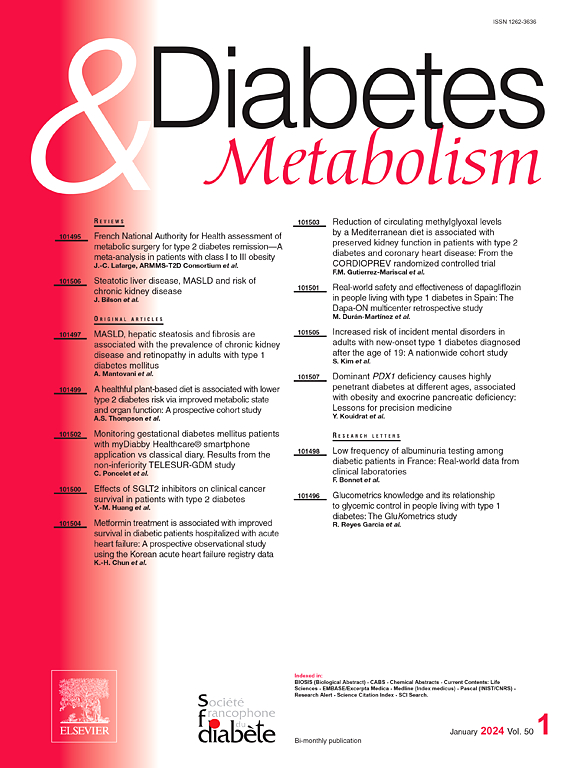Prevent hypoglycaemia when using automated insulin delivery systems in type 1 diabetes requires near normal glycaemic variability
IF 4.7
2区 医学
Q1 ENDOCRINOLOGY & METABOLISM
引用次数: 0
Abstract
Aim
Although newer technologies of insulin delivery in type 1 diabetes have facilitated an improvement in glycaemic control the risk of hypoglycaemia remains a threat. Therefore, it is important to define the thresholds of glycaemic variability below which the risk of hypoglycaemia can be eliminated or at least minimized.
Methods
Randomized controlled trials conducted from 2017 to 2023 comparing Sensor-Augmented-Pumps and Augmented Insulin Delivery Systems (n = 16 and 22 studies, respectively) were selected. A weighted linear model of regression was used to compute the relationship between glycaemic variability and times spent below glucose range. The intercepts of regression lines with the abscissa axis (time below range = 0 %) defined the glycaemic variability thresholds.
Results
Positive relationships were observed between the 2 metrics. The scatter plots indicated that the times spent below range never reached the value of 0 % and that the glycaemic variability never fell below 28 %. By extrapolating the regression lines, the glycaemic variability at intercepts with time below range < 70 mg/dL of 0 % was 30.1 % with sensor augmented pumps and 18.9 % with automated insulin delivery. For a time below range < 54 mg/dL of 0 % the respective glycaemic variability values were 32.7 % and 19.9 % (with sensor augmented pumps and automated insulin delivery, respectively).
Conclusions
Importantly, glycaemic variability targets and ambient hyperglycaemia are interdependent. Users of automated insulin delivery need to reach a glycaemic variability of 18 % to 20 % to minimize or eradicate the risk of hypoglycaemia. Such values are those observed in healthy non-diabetic people.
1 型糖尿病患者在使用胰岛素自动给药系统时,需要接近正常的血糖变异性才能预防低血糖。
目的:尽管 1 型糖尿病患者使用胰岛素给药的新技术改善了血糖控制,但低血糖风险仍然是一个威胁。因此,必须确定血糖变异性的阈值,低于该阈值时,低血糖风险可以消除或至少降至最低:选取了 2017 年至 2023 年期间进行的随机对照试验,比较了传感器增强泵和增强胰岛素给药系统(分别为 16 项和 22 项研究)。采用加权线性回归模型计算血糖变异性与低于血糖范围时间之间的关系。回归线与横轴的截距(低于血糖范围的时间 = 0%)定义了血糖变异性阈值:结果:观察到这两个指标之间存在正相关关系。散点图显示,低于量程的时间从未达到 0%,血糖变异性从未低于 28%。根据回归线推断,低于量程 70 毫克/分升的时间截距为 0% 时,传感器增强泵的血糖变异率为 30.1%,自动胰岛素输送的血糖变异率为 18.9%。对于低于范围 < 54 mg/dL 0% 的时间,血糖变异值分别为 32.7% 和 19.9%(使用传感器增强泵和自动胰岛素输送):重要的是,血糖变异性目标和环境高血糖是相互依存的。胰岛素自动给药用户需要达到 18% 至 20% 的血糖变化率,才能最大限度地降低或消除低血糖风险。这些数值是在健康的非糖尿病患者身上观察到的。
本文章由计算机程序翻译,如有差异,请以英文原文为准。
求助全文
约1分钟内获得全文
求助全文
来源期刊

Diabetes & metabolism
医学-内分泌学与代谢
CiteScore
12.00
自引率
4.20%
发文量
86
审稿时长
13 days
期刊介绍:
A high quality scientific journal with an international readership
Official publication of the SFD, Diabetes & Metabolism, publishes high-quality papers by leading teams, forming a close link between hospital and research units. Diabetes & Metabolism is published in English language and is indexed in all major databases with its impact factor constantly progressing.
Diabetes & Metabolism contains original articles, short reports and comprehensive reviews.
 求助内容:
求助内容: 应助结果提醒方式:
应助结果提醒方式:


